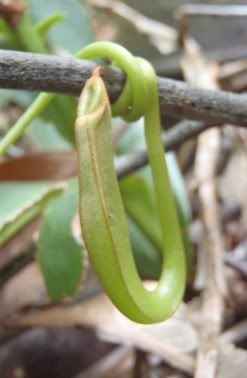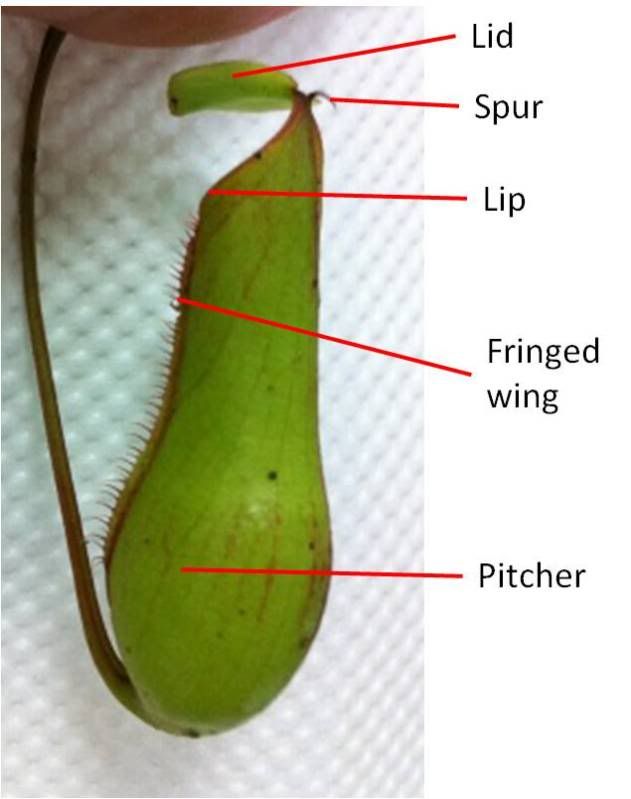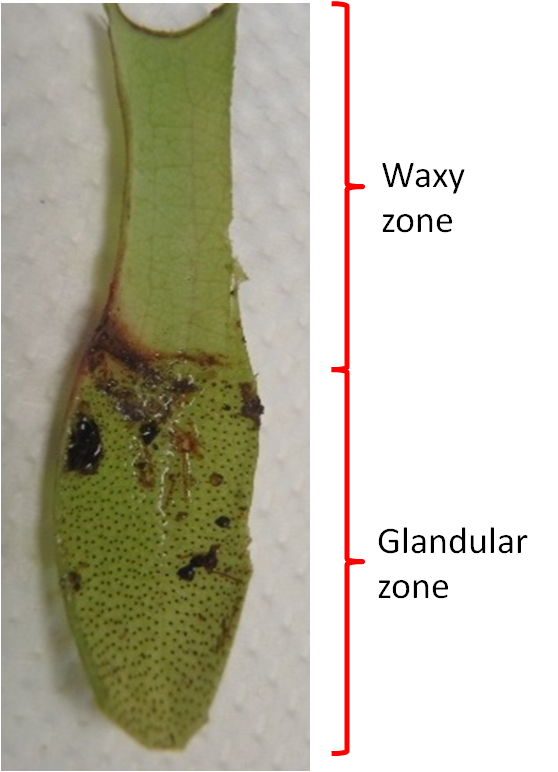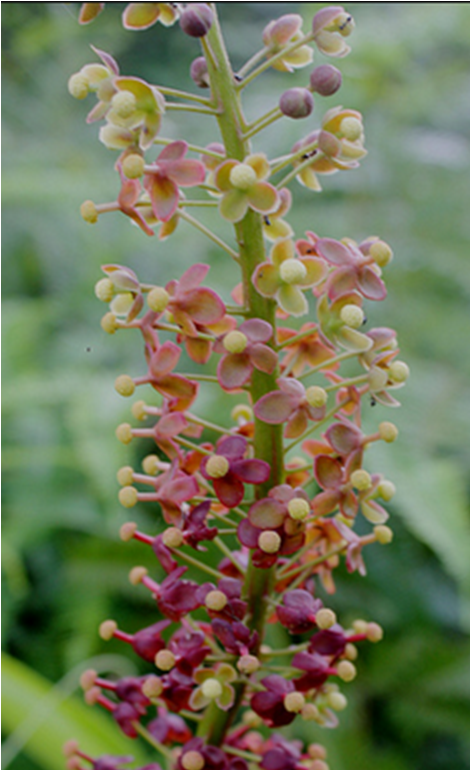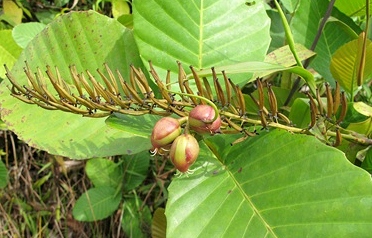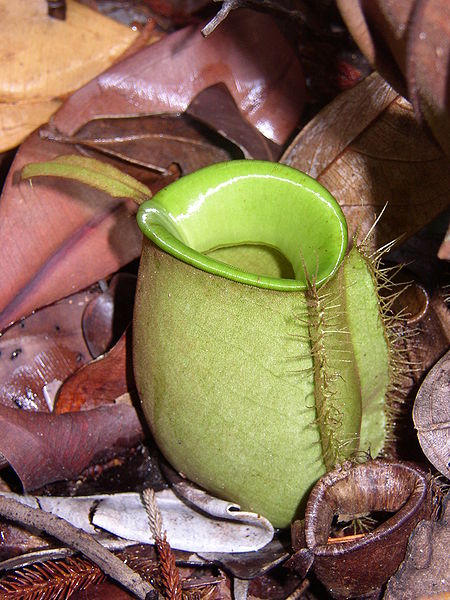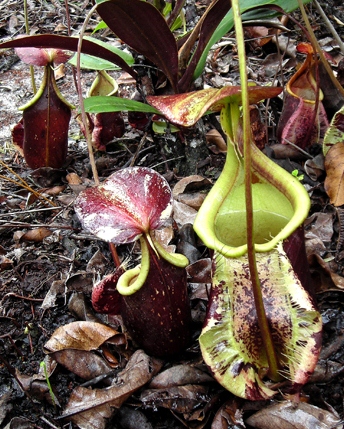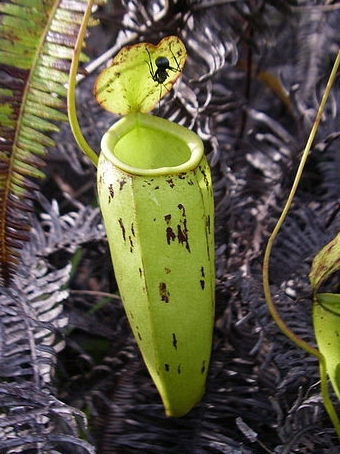Slender pitcher plant
Table of Contents
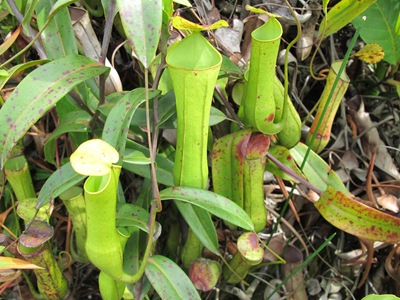 |
| Nepenthes gracilis in Tuas Marshland. Photo by: Teo Siyang |
Plants are generally viewed as rather defenseless, photosynthetic living things that by necessity produce thin leaves which may be easily found and are eaten by herbivores. However, pitcher plants challenge this paradigm that "animals eat plants" by using a modified structure on the leaf, the pitcher, to trap and digest prey! Out of the three native tropical pitcher plants found locally, the slender pitcher plant has gone one step further and makes use of the rain in the capturing of its prey, using raindrops to "catapult" insects seeking shelter under its lid into the pitcher! Read on to understand and further appreciate this native pitcher plant commonly found in Singapore.
 |
| Pitcher of Nepenthes gracilis. Photo by: Wensley |
| Slow motion video of Nepenthes gracilis using rain to catapult prey. |
Naming the Nepenthes gracilis
The genus name "Nepenthes" is derived from "ne penthos"; greek for "without grief", and the specific epithet "gracilis" is Latin for "slender", describing the slender shape of the pitcher compared to other tropical pitcher plants.
Vernacular name: Slender pitcher plant
Binomial name: Nepenthes gracilis (Korth, 1839)
Synonyms: Nepenthes korthalsiana, Nepenthes longinodis, Nepenthes laevis, Nepenthes angustifolia
Distribution
5 10 11 14Local Range
Fancy looking for these unique and exceptional plants? The slender pitcher plant is found locally in almost all forest types; marshlands (Tuas), parks (Kent Ridge), old secondary forests (Upper and Lower Pierce Reservoir), and primary rainforests (Bukit Timah Nature Reserve, Central Catchment Nature Reserve). Below is a map showing the general locations of where the Nepenthes gracilis was sighted with accompanying pictures. For nature lovers who would love to see this plants in the wild, do take note that it is illegal to pluck, cut or remove any plant from parks and reserves!| Map showing general locations of local sightings of Nepenthes gracilis. Source: Google Maps |
Native Range
The slender pitcher plant is distributed around tropical South-East Asia, in Thailand, Brunei, Indonesia, Malaysia and Singapore[a]
Ecology
Prey Catching Technique
2 3 4 6 12The pitcher of the Nepenthes gracilis works like a pitfall trap; insects are lured by the scent of the nectar in the pitcher and in the attempt to get to it, the loose waxy scales found on the waxy region of the pitcher causes the unfortunate bug to they lose their foothold, slip and fall. Fragrance of the nectar and the viscosity of the pitcher fluid affects the diversity as well as the capture rate of prey within these pitchers.
 |
| "(A) N. gracilis pitcher with visiting Polyrhachis pruinosa ant, showing the epicuticular wax crystal surfaces on the inner pitcher wall and on the underside of the pitcher lid. (B) The horizontal orientation directly above the pitcher opening puts the lower lid surface in an ideal position for prey capture." Source: Baur et al, 2012. PloS one |
However, a very recent discovery uncovered a different prey capture strategy that the Nepenthes gracilis employs. Compared to other tropical pitchers, the Nepenthes gracilis is unusual in that the underside of the lid of the pitcher also has a layer of wax crystals similar to those found in the inner walls of the pitcher. In fact, the lid was found to play a crucial role in prey capture; during a rain, insects seeking shelter by hiding under the lid of the pitcher would be 'catapulted' into the pitcher from the vibrations caused by raindrops falling on the pitcher.
Trapping mechanism of Nepenthes gracilis under a simulated rain condition.
Pitcher Fauna Composition
8 16The composition of fauna within the pitcher plant is not merely prey items. As a result of having a 'pool' of decaying insects, the detritus produced from the digestion of drowned prey are fed on by detritus feeders, which are in turn fed on by higher trophic level feeders such as gall and phantom midges. Aquatic filter feeders of bacteria and fungi present in the fluid such as mosquito larvae are a common sight as well. These are then fed on by terrestrial predators such as the crab spider which lies in wait above the pitcher.
 |
| Content in a pitcher plant. Photo by:Wensley |
Below are some of the organisms and dead matter that can be found in the pitcher's mini-ecosystem:
 |
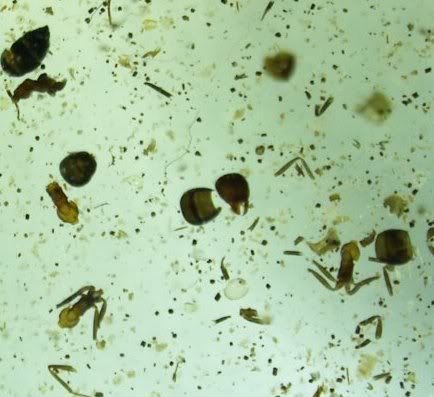 Older organic debris |
 Detritus feeders (Aquatic mite) |
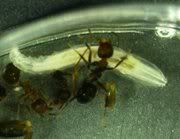 Detritus feeder (Aquatic nematode) |
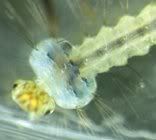 Filter feeders (Mosquito larvae) |
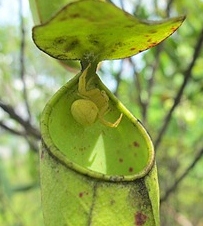 Terrestrial crab spider. Photo by: Teo Siyang |
Description
1 5 9 10 13 16HabitNepenthes gracilis are perennial climbers; they usually grow to about 2-6 metres long, but may grow longer, either trailing the ground or climbing up other plants. They climb using the tendrils located on the tip of their modified leaves. Leaves on lower branches are arranged in rosettes to maximize photosynthetic efficiency, while upper branches are more elongate. |
|
|
||||
Leaf/StemThe leaf of the Nepenthes gracilis is attached to the stem via a winged stalk. The leaf blade is continuous with the wings, and the tip of the leaf is a slender coiling tendril used for looping around supporting structures. The tip of the tendril then develops into a pitcher.
|
|
|||||
PitcherDifferent tropical pitcher plant species have pitchers of various shapes and have distinct structures which allows for differentiation between species. The tip of the tendril forms the lid of the pitcher, with an outward-pointing spur at the lid base. The lip of the pitcher mouth is unribbed and smooth. The pitcher itself is slightly hipped; and in the pitcher of the lower branches ,the fringed wings are more conspicuous compared to those on the upper branches, where the fringed wings are merely short ridges.Internally, the pitcher is broadly differentiated to two zones; the waxy zone and the glandular zone. The waxy zone is smooth and slippery, causing insects to lose their foothold and slip into the pitcher. The glandular zone is responsible for secreting the pitcher fluid, which 'digests' the unfortunate prey. |
|
|
||||
Flowers and FruitAn inflorescence (cluster of flowers arranged on a stem) is produced from the tip of an upper branch of the slender common pitcher. This inflorescence is erect and consists of flowers along a vertical stem. Each individual flower consist of 4 nectar secreting tepals which attract insects to pollinate them. After pollination, the flowers develop into specialised fruit known as capsules, which break open when ripe to release the seeds, which are then pollinated via wind dispersal. |
|
|
||||
Cultural Significance
[b]Medicinal
In Malay folk medicine, the root of the Nepenthes gracilis was ground used to treat gastrointestinal disorders, dysentry and as a poultice. The stem was used to relieve coughs and fevers, and thought to be effective in inducing vomitting. Fluids of unopened pitchers were used for treating burns and skin disorders.
Superstition
Pitchers of the Nepenthes gracilis was supposedly used by Malay shamans for exorcisms and in religious rites to bring rain!
Local Hybrids
15 16Singapore is home to 3 species of the Nepentheceae; Nepenthes gracilis, Nepenthes ampullaria as well as the Nepenthes rafflesiana, of which the Nepenthes gracilis is the most commonly found locally. Locally, hybrids have been sighted occuring naturally in the wild between these species.
Below is a table showing the images of the three native species (top row) and their corresponding hybrids (bottom row):
Nepenthes ampullaria
|
Nepenthes gracilis
|
Nepenthes rafflesiana
|
||||||
| Nepenthes gracilis x Nepenthes ampullaria
|
Nepenthes gracilis x Nepenthes rafflesiana
|
- N. albomarginata × N. gracilis
- (N. ampullaria × N. gracilis) × N. bicalcarata
- N. bicalcarata × N. gracilis
- N. gracilis × N. mirabilis
- N. gracilis × N. northiana
- N. gracilis × N. reinwardtiana
- N. gracilis × N. sumatrana
Taxonomy
7Interested to know the relationships between Nepenthes gracilis and other carnivorous plants? Below is a phylogenetic tree showing the placement of the slender pitcher plant among the Nepenthes in relation to other carnivorous plants. You can compare the differences between the Nepenthes gracilis and some of its carnivorous counterparts by browsing the photostream and other pictures on the left!
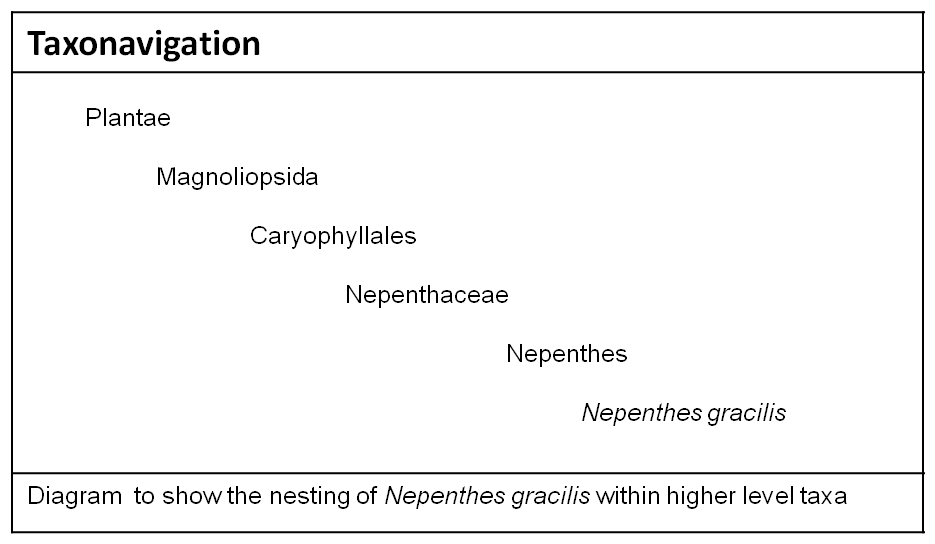
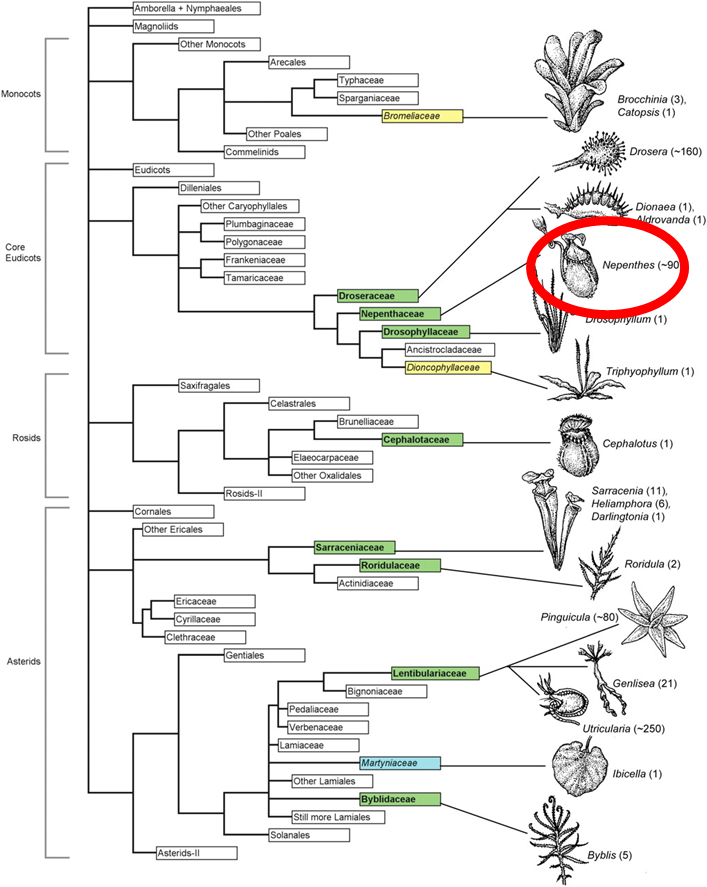 |
| Positions of carnivorous plant families in the current overall angiosperm phylogeny. Source: Journal of Experimental Botany |
 |
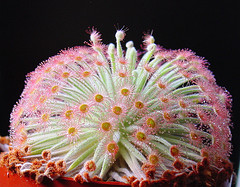 |
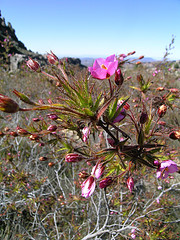 |
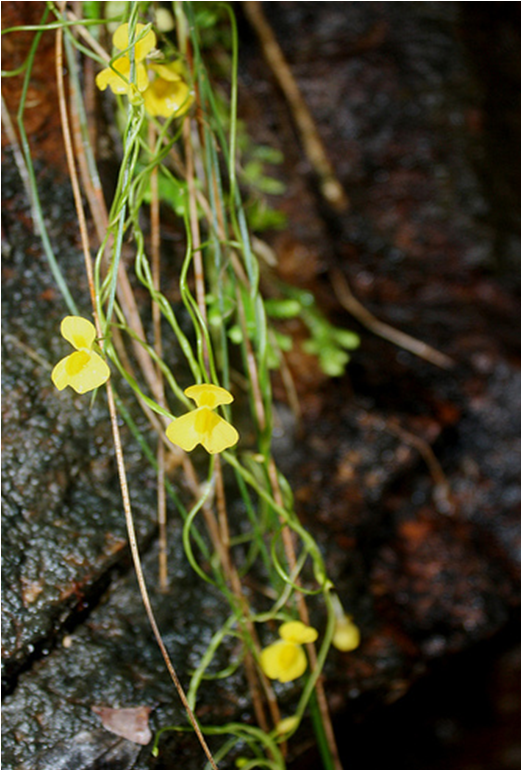 |
Comments
If you are unsure about any topic, would like to seek clarification on any segment of the page, or would like to contribute or add any information, do not hesitate to send your queries or thoughts to slenderpitcherinfo@gmail.com
Literature Cited
- Bailey, Liberty Hyde. "The standard cyclopedia for horticulture."The standard cyclopedia for horticulture.(1939).
- Bauer, U., Di Giusto, B., Skepper, J., Grafe, T. U., & Federle, W. "With a Flick of the Lid: A Novel Trapping Mechanism in Nepenthes gracilis Pitcher Plants." PloS one 7.6 (2012): e38951.
- Bauer, Ulrike, Holger F. Bohn, and Walter Federle. "Harmless nectar source or deadly trap: Nepenthes pitchers are activated by rain, condensation and nectar."Proceedings of the Royal Society B: Biological Sciences275.1632 (2008): 259-265.
- Bauer, U., et al. "Form follows function: morphological diversification and alternative trapping strategies in carnivorous Nepenthes pitcher plants."Journal of Evolutionary Biology(2012)
- Clarke, Charles. "Nepenthes of Borneo."Kota Kinabalu, Sabah: Natural History Publications (Borneo) xi, 207p-col. illus.. ISBN1248185562 (1997)
- Di Giusto, B., Grosbois, V., Fargeas, E., Marshall, D. J., & Gaume, L. (2008). Contribution of pitcher fragrance and fluid viscosity to high prey diversity in a Nepenthes carnivorous plant from Borneo.Journal of Biosciences,33(1), 121-136.
- Ellison, Aaron M., and Nicholas J. Gotelli. "Energetics and the evolution of carnivorous plants—Darwin's ‘most wonderful plants in the world’." Journal of Experimental Botany 60.1 (2009): 19-42.
- H Adam, Jumaat. "Prey Spectra of Bomean Nepenthes Species (Nepenthaceae) in Relation to their Habitat."Pertanika Journal of Tropical Agricultural Science20.2/3 (1997): 121-134.
- Kato, Makoto. "Floral biology of Nepenthes gracilis (Nepenthaceae) in Sumatra."American journal of botany(1993): 924-927.
- Lloyd, Francis Ernest. "The carnivorous plants."The carnivorous plants.(1942).
- McPherson, Stewart.Pitcher plants of the Old World. Eds. Alastair Robinson, and Andreas Fleischmann. Vol. 2. Redfern Natural History Productions, 2009.
- Moran, Jonathan A., Webber E. Booth, and Joseph K. Charles. "Aspects of Pitcher Morphology and Spectral Characteristics of Six BorneanNepenthesPitcher Plant Species: Implications for Prey Capture."Annals of Botany83.5 (1999): 521-528.
- Clarke, Charles. "A guide to the pitcher plants of Peninsular Malaysia." Kota Kinabalu: Natural History Publications (Borneo) 32p.-col. illus.. ISBN1248186026 (2002).
- Sim, J. W. S., H. T. W. Tan, and I. M. Turner. "Adinandra belukar: an anthropogenic heath forest in Singapore."Plant Ecology102.2 (1992): 125-137.
- Tan, W. K., C. L. Wong, and C. K. Frazier. "Natural hybrid: nepenthes x (rafflesiana and gracilis)?."Nature Malaysiana21 (1996).
- Tan, Hugh TW. "A guide to the carnivorous plants of Singapore." Singapore: Singapore Science Centre 176p-. ISBN 1220151704 (1997).


